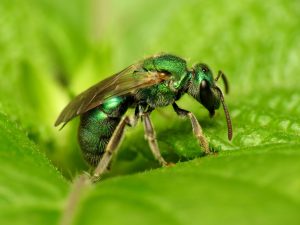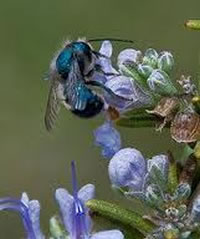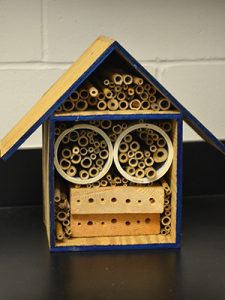
Bees. We would literally be starving without them. A popular statistic declares that 1 out of every 3 bites we eat would be impossible without the work of bees. Why is this? Surely most of us don’t eat that much honey on a daily basis. We do, however, eat apples, potatoes, peppers, watermelons, avocados, cherries, blueberries, and tomatoes, just a small number of popular food items pollinated by bees. Even our morning coffee and cotton clothing are dependent on bee pollinators. Without insect pollinators, including 3,500 species of bees just in the United States, these crops would never produce at a level adequate for feeding the larger world.

In addition to our hardworking honeybees, there are over 320 native Florida pollinator species that maintain healthy populations of wildflowers and native tree species. Some of these pollinators are nearly unrecognizable as the bees we’ve grown up knowing. Most of us immediately picture a fat, fuzzy, yellow and black striped insect buzzing around the garden. But many of the native bees are as diverse as the flowers they pollinate.
For example, the sweat bee is a shiny metallic emerald green in color. They are given this odd moniker due to their attraction to human sweat—in fact, they may land on you on a hot summer day to take in sodium and proteins from your sweat. Sweat bees pollinate wildflowers like Spanish needle and dune sunflower, along with fruit like apples and cherries.

The orchard mason bee is small, elongated, and easily mistaken for a beetle. Its coloration can be a brilliant royal blue. Mason bees are solitary bees and seal up the openings to their nests with soil and mud. As their name implies, the orchard mason bee is crucial for fruit orchards, pollinating almonds and stone fruits like plums, pears, and peaches.

One of our rare beach dune bees is out working right now, making its appearance on a bright yellow flower called the Gulf Coast honeycombhead (Balduina) This bee is endemic to the northern Gulf Coast, found only on beaches from coastal Mississippi to Bay County, Florida. Like other solitary bee species, it nests alone in an underground cavity instead of a hive of thousands.
There are many things that Florida residents can do to help promote bee populations. These include planting native flowers and trees—especially different species that bloom at different times of the year—and reducing or eliminating pesticide use. Installing “pollinator houses,” made of horizontal bamboo shoots, can provide safe haven for a wide variety of bee species and even prevent carpenter bees from drilling into wood structures. If you see an interesting bee you don’t recognize, check out this beautifully illustrated publication from UF IFAS Communications–it shows examples of the wide variety of size, shape, and color of Florida bee species.
 9
9
